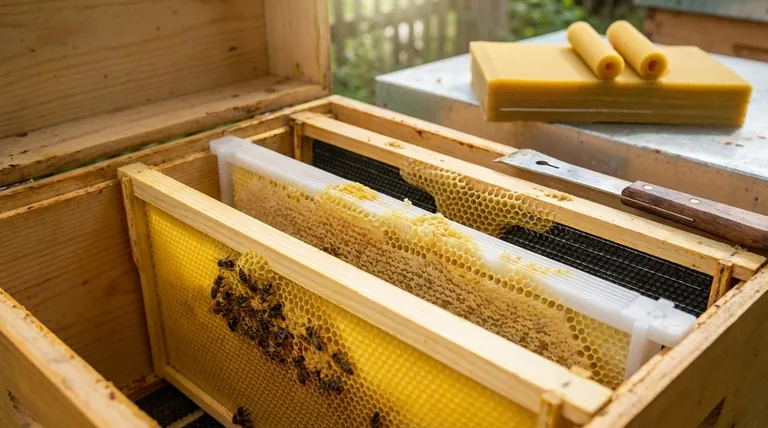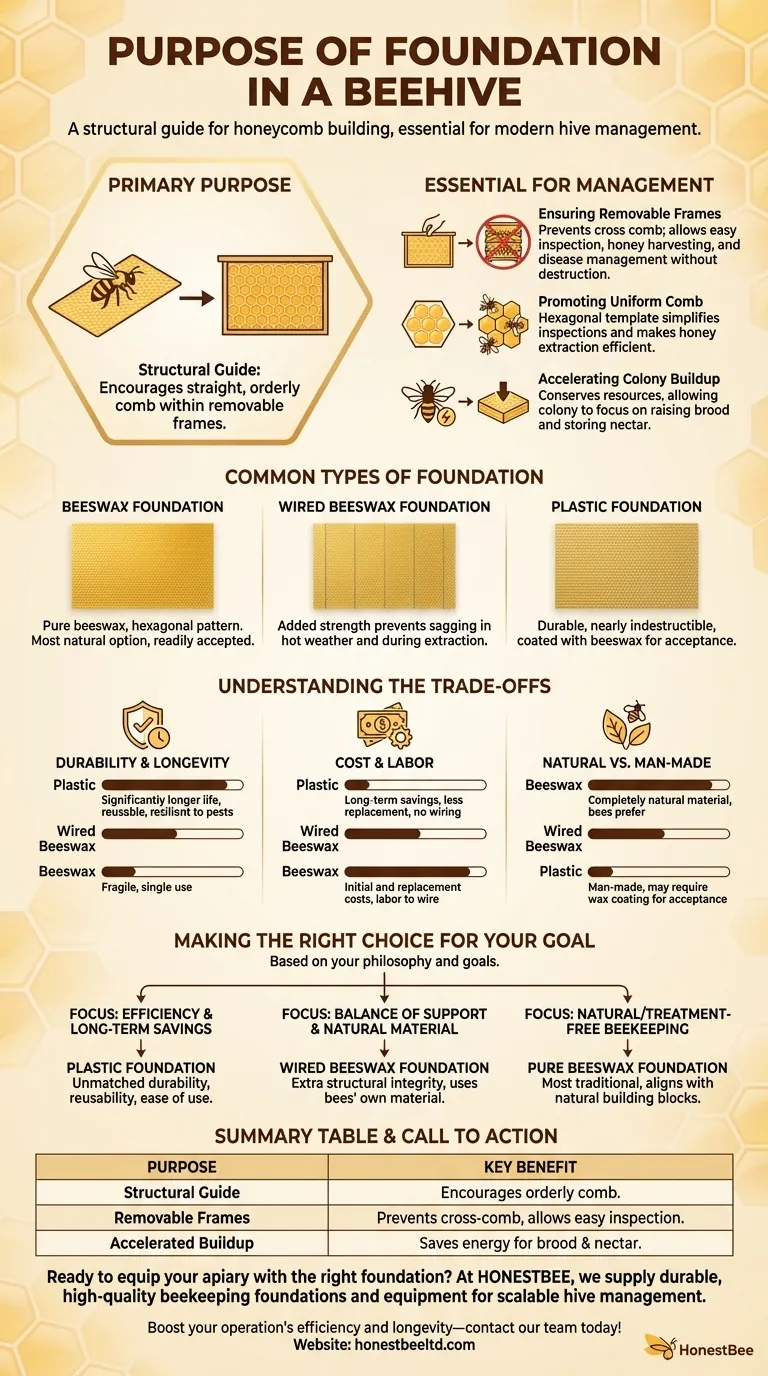The primary purpose of foundation in a beehive is to give honey bees a structural guide for building their honeycomb. It is typically a thin sheet of plastic or beeswax imprinted with a hexagonal cell pattern, which encourages bees to build straight, orderly comb within the confines of a removable frame.
At its core, foundation is a management tool that imposes order on the hive's natural construction. This ensures beekeepers can easily remove frames for inspection, disease management, and honey harvesting without destroying the comb or harming the colony.

Why Foundation is Essential for Management
Ensuring Removable Frames
Without guidance, bees will build comb in their own beautifully chaotic way, often connecting it between multiple frames and to the hive walls. This is called cross comb or burr comb.
This natural building method effectively glues the frames together, making it impossible to remove a single frame without cutting through the comb, destroying brood, and spilling honey.
Foundation directs the bees to build only within the perimeter of each frame, keeping them separate and easily removable.
Promoting Uniform Comb
The hexagonal pattern imprinted on foundation provides a perfect template. Bees use this as a starting point, quickly building out uniform, straight cells.
This orderly structure simplifies hive inspections and makes the process of extracting honey far more efficient.
Accelerating Colony Buildup
Creating beeswax from scratch requires a tremendous amount of energy from the bees.
By providing a pre-made base structure, foundation allows the colony to conserve resources and accelerate the process of drawing out comb, freeing them up to focus on raising young bees and storing nectar.
Common Types of Foundation
Beeswax Foundation
This is a pure sheet of beeswax, often milled with the hexagonal cell pattern. It is the most natural option and is readily accepted by bees.
Wired Beeswax Foundation
For added strength, thin vertical wires are often embedded within the beeswax foundation.
This reinforcement prevents the heavy, wax-filled comb from sagging or collapsing, especially in hot weather or during honey extraction.
Plastic Foundation
Plastic foundation is a rigid, durable alternative that is nearly indestructible. It is almost always coated with a thin layer of beeswax to encourage the bees to accept it and begin building on it.
Understanding the Trade-offs
Durability and Longevity
Plastic foundation has a significantly longer life than beeswax. It stands up to repeated use and the stress of honey extraction without breaking.
It is also resilient against pests like wax moths. Damaged frames can be scraped clean, power washed, and reused, which is not possible with fragile beeswax.
Cost and Labor
While the initial cost might be similar, plastic foundation leads to long-term savings in cost, time, and labor.
It eliminates the time-consuming task of wiring frames and is less frequently replaced, making it a highly efficient option for beekeepers managing multiple hives.
Natural vs. Man-Made
The primary argument for beeswax foundation is that it is a completely natural material. Some beekeepers prefer to keep everything inside the hive as close to nature as possible.
Bees also tend to accept and draw out wax foundation more readily than plastic, although a good wax coating on plastic foundation minimizes this difference.
Making the Right Choice for Your Goal
Selecting a foundation type depends entirely on your beekeeping philosophy and operational goals.
- If your primary focus is efficiency and long-term cost savings: Plastic foundation is unmatched in its durability, reusability, and ease of use.
- If your primary focus is a balance of support and natural material: Wired beeswax foundation provides extra structural integrity while using the bees' own material.
- If your primary focus is natural or treatment-free beekeeping: Pure beeswax foundation is the most traditional choice, aligning perfectly with the bees' natural building blocks.
Ultimately, choosing the right foundation is about balancing the natural tendencies of your bees with your specific goals as a beekeeper.
Summary Table:
| Purpose | Key Benefit |
|---|---|
| Structural Guide | Encourages bees to build straight, orderly comb within frames. |
| Removable Frames | Prevents cross-comb, allowing for easy hive inspection and honey harvesting. |
| Accelerated Buildup | Saves bees energy, allowing them to focus on brood rearing and nectar collection. |
Ready to equip your apiary with the right foundation?
At HONESTBEE, we supply durable, high-quality beekeeping foundations and equipment to commercial apiaries and distributors. Whether you prioritize the efficiency of plastic foundation or the natural appeal of beeswax, we provide the wholesale solutions you need for successful, scalable hive management.
Boost your operation's efficiency and longevity—contact our team today to discuss your needs!
Visual Guide

Related Products
- Beeswax Foundation Sheets Beehive Foundation for Wholesale
- Notebook Style Beeswax Foundation Mould Wax Foundation Mold
- Food Grade Plastic bee Foundation for Bee Frames
- Colorful Silicone Beeswax Foundation Mold Mould for Beekeeping
- Manual Beeswax Comb Foundation Machine Wax Foundation Mill Embossing Machine
People Also Ask
- What happens if foundation is given to colonies during a nectar dearth? Avoid Wasted Equipment and Stressed Bees
- What are the potential issues if the wax or dipping process is not properly managed? Avoid Cracks, Ripples, and Delamination
- How do beeswax foundations save bees time and energy? Boost Hive Productivity & Honey Yield
- What are wax sheets made of? A Guide to Pure Beeswax Foundation for Healthy Hives
- What is beeswax foundation used for? A Guide to Efficient Hive Management



















